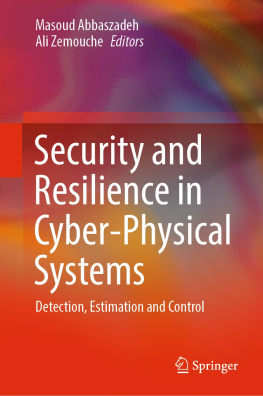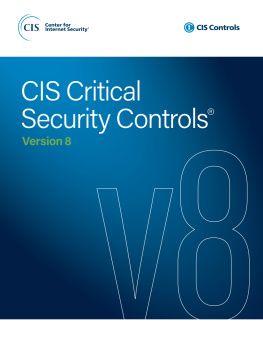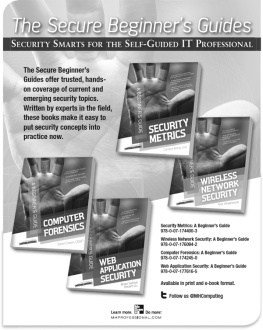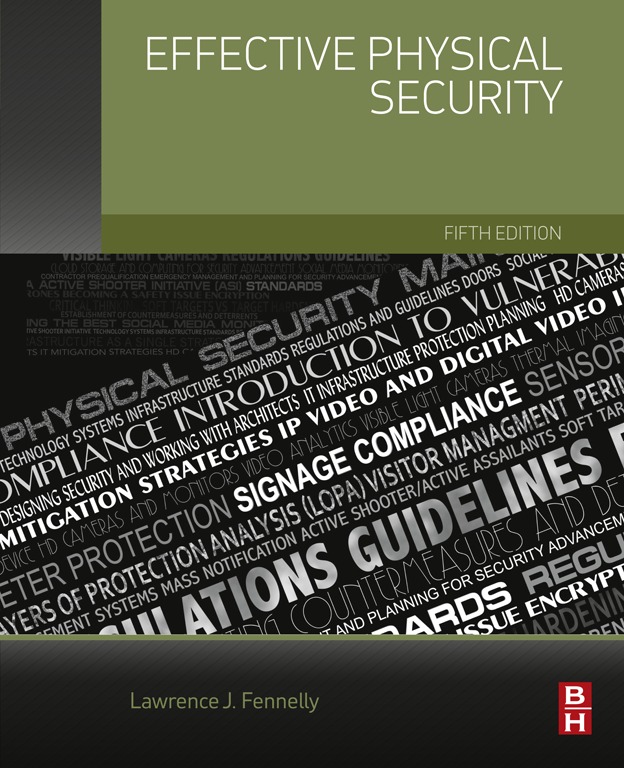Table of Contents
List of Figures
- Figures in Chapter 1
- Figures in Chapter 2
- Figures in Chapter 4
- Figures in Chapter 6
- Figures in Chapter 7
- Figures in Chapter 8
- Figures in Chapter 9
- Figures in Chapter 12
- Figures in Chapter 18
- Figures in Chapter 19
- Figures in Chapter 20
- Figures in Chapter 21
- Figures in Chapter 23
List of Tables
- Tables in Chapter 2
- Tables in Chapter 4
- Tables in Chapter 5
- Tables in Chapter 20
- Tables in Chapter 22
- Tables in Chapter 23
Landmarks
Effective Physical Security
Fifth Edition
Table of Contents
Copyright
Butterworth-Heinemann is an imprint of Elsevier
The Boulevard, Langford Lane, Kidlington, Oxford OX5 1GB, United Kingdom
50 Hampshire Street, 5th Floor, Cambridge, MA 02139, United States
Copyright 2017 Elsevier Inc. All rights reserved.
No part of this publication may be reproduced or transmitted in any form or by any means, electronic or mechanical, including photocopying, recording, or any information storage and retrieval system, without permission in writing from the publisher. Details on how to seek permission, further information about the Publishers permissions policies and our arrangements with organizations such as the Copyright Clearance Center and the Copyright Licensing Agency, can be found at our website: www.elsevier.com/permissions.
This book and the individual contributions contained in it are protected under copyright by the Publisher (other than as may be noted herein).
Notices
Knowledge and best practice in this field are constantly changing. As new research and experience broaden our understanding, changes in research methods, professional practices, or medical treatment may become necessary.
Practitioners and researchers must always rely on their own experience and knowledge in evaluating and using any information, methods, compounds, or experiments described herein. In using such information or methods they should be mindful of their own safety and the safety of others, including parties for whom they have a professional responsibility.
To the fullest extent of the law, neither the Publisher nor the authors, contributors, or editors, assume any liability for any injury and/or damage to persons or property as a matter of products liability, negligence or otherwise, or from any use or operation of any methods, products, instructions, or ideas contained in the material herein.
Library of Congress Cataloging-in-Publication Data
A catalog record for this book is available from the Library of Congress
British Library Cataloguing-in-Publication Data
A catalogue record for this book is available from the British Library
ISBN: 978-0-12-804462-9
For information on all Butterworth-Heinemann publications visit our website at https://www.elsevier.com/

Publisher: Todd Green
Acquisition Editor: Steve Merken
Editorial Project Manager: Nate McFadden
Production Project Manager: Stalin Viswanathan
Designer: Matthew Limbert
Typeset by TNQ Books and Journals
Dedication
It is with great happiness that we dedicate this book to our two very special daughters-in-law, Annmarie Carr Fennelly and Janet Mansfield Fennelly. Both of these strong women are working mothers, have three beautiful children each, and are wonderful Mothers, Wives, and our Daughters.
Larry and Annmarie Fennelly
Foreword
A manager designs and develops security, physical security, safety and investigative programs.
Louis A. Tyska, CPP
This book is your road map to decoding and developing an effective security strategy beginning with the design build phase and addressing everything in between including life safety issues. Larry Fennelly and Marianna Perry have the knowledge and experience to see these complicated and ever-changing security challenges from a unique and multifaceted viewpoint. They both share their insight with the reader and that is why every security practitioner needs to read this book. Most security books focus on one topic, i.e., Risk Analysis or Security Surveillance Systems (CCTV) and access control and biometrics. I love this text because it has so much material in it that we need to address our everyday problems.
The baby boomers are retiring and the millennium generation is taking over. The face of security is also changing. Research is being done to advance the security profession to provide the highest level of protection while at the same time, increasing the bottom-line profitability of the organization. College courses are changing. Going forward, the combination of business as a major field of study and security or information technology as a minor is becoming the new norm. This change is being implemented to prepare security professionals to properly protect corporate assets.
The new buzz words from 2015 to 2020 will be the following:
1. What kind of skill set does the candidate/officer have?
2. What certifications and specializations does the candidate/officer have?
3. Both physical security and informational security will be merging with the move toward certifications.
4. Career pathways will be used by way of internships.
5. Your certifications will be the bar for testing qualifications.
6. Education for a career in security is being redesigned. Are you ready?
7. The holistic approach is preferred over independent components or silos as a logical approach to security systems.
8. 5.0 Megapixel cameras on phones and monitors with full (or true) HDTV1080 are standard.
Do not be left behind! Plan for the future now !
The top crime threat problems according to recent reports are (1) cyber/communications security, (2) workplace violence, (3) business continuity, (4) insider threat, and (5) property crime.
We mention this because if you are going to be addressing crime problems you first need to know what they are. To make recommendations and solve problems, you first have to make sure that you have correctly identified the issue. If a security assessment is not completed to determine the root causes of a security issue or vulnerability, the security practitioner may simply keep putting policies or procedures in place that address the symptoms and countermeasures of a problem and not the actual problem itself. This will be a frustrating (and sometimes costly) situation that can be avoided if, before any action is taken, an assessment is completed by a knowledgeable security professional to accurately identify security vulnerabilities. This will ensure that the true issues and concerns are being addressed, not just the symptoms .
The most demanding problem for managers and supervisors within a protection department is the physical security devices under his/her control. The supervisors role should be to assist in enabling the manager to provide a level of support within the organization. Supervisors must take responsibility for corporate regulations, moral and ethical tone as well as providing the required level of security and customer service required.










